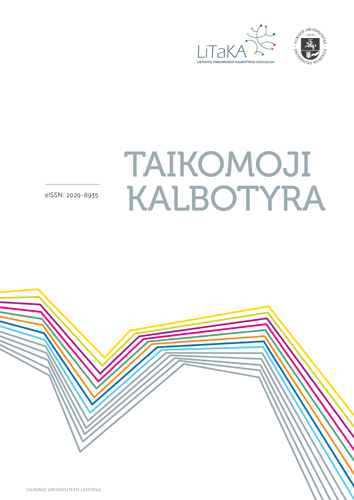Semantizmų vartosena teisės mokslo darbų rankraščiuose
On the use of semantic calques in academic legal written language
Author(s): Dalia GedzevičienėSubject(s): Law, Constitution, Jurisprudence, Lexis, Descriptive linguistics
Published by: Vilniaus Universiteto Leidykla
Keywords: lexicography; language of law; language of research; semantic calque; meaning;
Summary/Abstract: The use of semantic calques in academic legal written language is the focus of the present article. Semantic calques are words in new irregular meanings. The following two groups of semantic calques in academic legal written language are distinguished: old calques, which are produced in the Lithuanian language due to the impact of the Russian language, and new calques, which have been produced in the Lithuanian language due the impact of the English language. The most frequently used calques of the first group are the verbs (pa)talpinti, atstatyti, sutikti, naudoti and their derivatives, the adjectives pilnas, a, vieningas, a and their derivatives, the noun saugiklis. The most frequently used calques of the second group are the adjectives pilotinis, harmoningas, -a, the verb harmonizuoti and the noun harmonizavimas. The present paper aims to identify the key reasons why some semantic calques spread in the academic language of the law. According to the contact between the user of the calque and the foreign language of its origin, the article distinguishes two types of reasons: primary and secondary. Primary reasons (concerned with the direct contact between the user of the calque and the language of origin) can be divided into three general reasons: (1) life among bilingual population; (2) the author of the text is a non-native speaker of Lithuanian; (3) the author relies on secondary written sources (research papers, documents, legal acts) in foreign languages, especially on its non-professional translation. Secondary reasons are concerned with an indirect contact between the user of the calque and the language of origin. In many cases the user of the calque does not know the foreign language from which the calque has been adopted. Semantic calques are copied from administrative language (legal acts, codes), public spoken language and are the result of imitation. Due to secondary reasons the calque appearing in a narrow peripheral field of standard language is further transferred into general usage. The analysis of the texts has demonstrated that in most cases semantic calques spread in academic legal written language due to extralinguistic factors. For example, Soviet occupation is one of them, when Russian in fact had the status of a state language. Now we are in a different situation, when the EU membership requires that all legal acts be translated into national languages of all member states.
Journal: Taikomoji kalbotyra
- Issue Year: 2014
- Issue No: 5
- Page Range: 1-18
- Page Count: 18
- Language: Lithuanian

